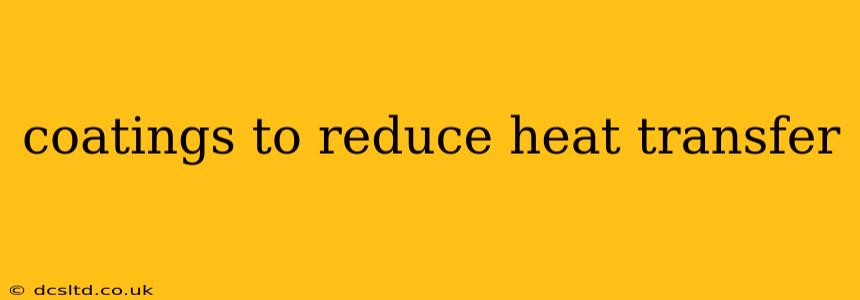Heat transfer is a fundamental aspect of many engineering and industrial processes. Minimizing unwanted heat transfer is crucial in various applications, from improving energy efficiency in buildings to protecting sensitive electronic components. This comprehensive guide explores various coatings designed to reduce heat transfer, examining their properties, applications, and limitations.
What are the Different Types of Coatings Used to Reduce Heat Transfer?
Several types of coatings effectively reduce heat transfer, each with unique properties and applications. These include:
-
Reflective Coatings: These coatings work by reflecting a significant portion of incident radiant heat away from the surface. Common materials include aluminum, silver, and other highly reflective metals. The effectiveness of these coatings depends on the surface smoothness and the wavelength of the incident radiation. Highly polished surfaces generally exhibit better reflectivity.
-
Insulating Coatings: These coatings act as thermal barriers, slowing down the conduction and convection of heat. They often incorporate porous materials or air pockets to trap air, a poor conductor of heat. Examples include aerogels, polyurethane foams, and various ceramic-based insulations. The thickness of the coating plays a significant role in its insulating capability. Thicker coatings provide better insulation.
-
Emittance Coatings: These coatings reduce the rate at which a surface emits thermal radiation. Low-emittance (low-e) coatings are commonly used in windows to minimize heat loss during winter and heat gain during summer. These coatings often consist of thin layers of metallic oxides or nitrides.
-
Phase Change Material (PCM) Coatings: These coatings utilize materials that absorb or release latent heat during phase transitions (e.g., melting or freezing). This helps to maintain a relatively stable temperature at the surface, reducing temperature fluctuations and heat transfer.
What are the Key Properties of Heat Transfer Reducing Coatings?
The effectiveness of a heat transfer reducing coating depends on several key properties:
-
Thermal Conductivity: A lower thermal conductivity indicates a better insulator. This property governs the rate at which heat is conducted through the coating.
-
Reflectivity: The ability of the coating to reflect incident radiation. High reflectivity minimizes the amount of heat absorbed by the surface.
-
Emissivity: The ability of the coating to emit thermal radiation. Low emissivity minimizes the amount of heat radiated from the surface.
-
Durability: The coating's ability to withstand environmental factors such as weathering, abrasion, and chemical attack. A durable coating ensures long-term performance.
-
Adhesion: The coating must adhere strongly to the substrate to prevent delamination and ensure effective heat transfer reduction.
How are Heat Transfer Reducing Coatings Applied?
The application method varies depending on the type of coating and the substrate. Common techniques include:
- Spray coating: Suitable for various coatings and provides uniform application over large areas.
- Dip coating: An immersion process ideal for uniform coating of smaller objects.
- Electrodeposition: An electrochemical process for applying coatings, often used for metallic coatings.
- Vacuum deposition: Used for applying thin, highly reflective coatings.
What are Some Common Applications of Coatings to Reduce Heat Transfer?
Coatings designed to reduce heat transfer find applications across various industries, including:
- Building and Construction: Reducing energy consumption in buildings through improved insulation in walls, roofs, and windows.
- Automotive Industry: Enhancing fuel efficiency and reducing engine temperatures.
- Aerospace Industry: Protecting sensitive components from extreme temperatures.
- Electronics Industry: Preventing overheating of electronic devices and improving their lifespan.
- Solar Energy: Enhancing the efficiency of solar panels by reducing heat loss.
What are the Advantages and Disadvantages of Using Coatings to Reduce Heat Transfer?
Advantages:
- Improved energy efficiency: Reducing energy consumption in buildings and industrial processes.
- Enhanced component protection: Preventing overheating and damage to sensitive components.
- Increased lifespan of equipment: Extending the operational life of various devices and systems.
- Cost-effectiveness: In the long run, reduced energy consumption can offset the initial cost of the coating application.
Disadvantages:
- Initial application cost: The cost of applying the coating can be significant, depending on the type of coating and application method.
- Durability concerns: Some coatings may degrade over time due to environmental exposure.
- Compatibility issues: The coating must be compatible with the substrate material to ensure proper adhesion and performance.
What factors should I consider when choosing a heat transfer reducing coating?
Selecting the appropriate coating requires careful consideration of several factors:
- The specific application and its requirements. What level of heat reduction is needed? What environmental conditions will the coating be subjected to?
- The substrate material. The coating must be compatible with the substrate to ensure good adhesion and performance.
- The cost of the coating and its application. Balance the cost with the long-term benefits of improved energy efficiency and component protection.
- The durability and lifespan of the coating. Choose a coating that can withstand the anticipated environmental conditions and maintain its effectiveness over time.
This guide provides a comprehensive overview of coatings to reduce heat transfer. The specific choice of coating will depend on the individual application and its unique demands. Remember to consult with experts to determine the best solution for your specific needs.
